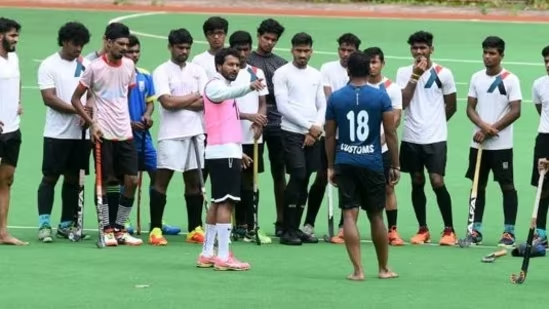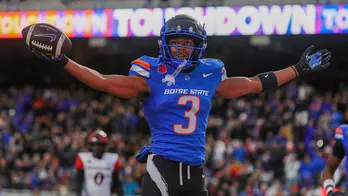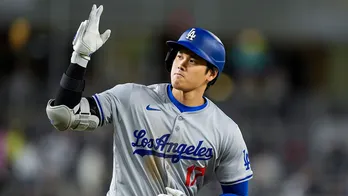Mumbai in the margins as India cheers the Tokyo hockey high
As the Indian men’s hockey team outclassed Great Britain in the Tokyo Olympics quarter-finals, about 40 kids watched it unfold at the Mumbai Hockey Association (MHA) premises. Devindar Walmiki, a regular at the MHA ground for training, had set up a screen in the hall and handed each kid a diary to note down points from the match. “Believe me, even the people who water the turf, the watchman… everyone joined in to watch. It was such an exciting atmosphere,” said Walmiki.  PREMIUM
PREMIUM
This kind of buzz has become all too rare in Mumbai hockey, so has Mumbai hockey’s presence at the national level.
Walmiki is the last hockey Olympian from the metro; he was the lone Mumbai player in the 2016 Rio Olympics squad. The 2020 Tokyo Games squads had none. In the 30-man core group at the national camp, there is one from Mumbai—goalkeeper Suraj Karkera. In the junior squad, there are two—Darshan Gawkar and Mohammad Sadiq.
For a city that consistently fed a battery of players into the national setup, the decline has been stark.
Mumbai has a rich hockey history, having churned out Olympic medallists and internationals, from Leo Pinto to Randhir Singh Gentle to Govind Perumal through the 1940s and 50s, from Balbir Singh Grewal to Gurbax Singh Grewal to Kulwant Arora to Joe Antic through the 60s and 70s; from MM Somaya to Mervyn Fernandes to Joaquim Carvalho to Marcellus Gomes through the 80s and 90s; from Dhanraj Pillay to Viren Rasquinha to Gavin Ferreira to Jude Menezes through the turn of the century and from Adrian D’Souza to the Walmiki brothers Davindar ad Yuvraj more recently.
“If things don’t change in Mumbai hockey, we’ll only be left lamenting and talking about the good old days,” Rasquinha said.
The factors are manifold: lack of tournaments, coaching camps, grassroots programme, administrative apathy and corporates pulling the plug.
The most pressing, quite simply, is the absence of an avenue to play the sport round the clock in the city. Apart from a few tournaments in a year—the Bombay Gold Cup, for example—there is hardly any competitive action at the MHA. “Just conducting a few tournaments every year does not suffice. The more you play, the more you develop,” said Carvalho, the 1984 Olympian and former national coach.
“Why are the Punjab kids so good? Because there are so many academies there in which they are honing their skills every single day,” said Rasquinha, the former India captain.
The issue has its roots at school level. Marzban Patel—Dronacharya awardee hockey coach’s heart lies in grassroots hockey and he has helped develop many Olympians from the city—said there is a large vacuum from the U-16 to college levels due to a lack of tournaments, infrastructure and incentives.
“At U-16 level, hardly 6-7 schools remain in terms of quality competition,” said Patel, popularly known as Bawa. “Then at the college and university levels, there are hardly 1-2 tournaments. There is still some good talent, but it drifts to academics; because there’s no guarantee they will get anywhere in hockey,” Patel, 71, added.
Lawrence Bing, hockey secretary of Mumbai Schools Sports Association (MSSA), says his body organises one knockout and one league-cum-knockout tournament across age-groups from November to February. “The biggest hurdle is access to grounds. We have only two grounds—MHA and SAI. Everywhere else they charge a lot of money,” said Bing.
The dearth of grounds and hockey academies in Mumbai forces Patil to take his current bunch of boys twice a week to train on a rented turf in a mall, where each session costs ₹1,200.
Somaya, a member of the 1980 Moscow Olympics gold-winning side and a former captain, felt a chain in Mumbai hockey for the last 3-4 decades has been snapped. “There were important links (for talent supply)… the first was the school level, where a lot of good teams competed in tournaments; then was the college level, from about 40 teams earlier we now have just 10 or so; then came the uppermost link after the club level, which gave employment. The jobs are drying up. Earlier, Tatas, Mahindras, Railways, Indian Navy and about 6-7 banks would hire 30-35 boys every year. So, there was a chance right through the chain for those who aspired to play hockey,” Somaya said.
Corporates like Tatas and Mahindras, who fielded strong teams in the local leagues, are no longer around. “If the association can show that hockey is run well in the city, teams will come back. But you need to add credibility and structure to the programme,” he added.
The administrators blame a lack of funds. Bing said his budget to conduct a 45-day tournament is restricted to ₹3.5 lakh. Recently, MSSA asked boys selected for Hockey India’s (HI) sub-junior and junior academy national championship to shell out ₹3,000 each to go for competitions in Bhopal.
“If you can’t raise funds to send teams for tournaments, something as basic, then why are you sitting there?” asked Rasquinha, CEO of Olympic Gold Quest.
Carvalho is one of the few former players who was in the MHA managing committee with Gurbax Singh as secretary in a four-year term around a decade ago. In 2015, the entire player body that contested lost to the panel led by current president Mangha Singh Bakshi. “Despite the resistance we faced during our tenure, we got the (MHA ground) turf replaced, floodlights and electronic scoreboard installed, repaired the dressing rooms, built the hall of fame. But we were in a minority and got shunted out,” Carvalho said.
Rasquinha helps raise funds to keep Bombay Republicans—a club that is home to many former internationals was run by Patel for years and is now under his pupil Conroy Remedios—running. The Walmiki brothers share their experience of playing for India, and in Devindar’s case in the Dutch league currently, with the MHA trainees. “We need to place emphasis on kids. I plan to help as much as I can. Whatever I am is because of Bawa sir, Dhanraj sir and Mumbai hockey. I want to see Mumbai hockey back in the national scheme again,” he said.
One-state-one-unit setback
The one-state-one-association policy enforced by HI last year has further pushed Mumbai to the fringes. From three associations—MHA, Hockey Maharashtra and Vidarbha Hockey Association—sending teams for the national championships, the state now has just one association and team.
After the rule was implemented in July last year, 12 former Mumbai players wrote to then sports minister Kiren Rijiju urging him to reverse the policy and save Mumbai hockey. Carvalho, one of the signatories, hopes the new sports minister Anurag Thakur will look into the issue, having opposed the policy when he was BCCI president. “Otherwise, it will be the final nail in the coffin for Mumbai hockey,” said Carvalho.
Tokyo shot in the arm
Bleak as it may look, India’s Olympic bronze medal has given a shot in the arm to hockey in the country, the tremors of which have been felt in Mumbai as well. Bing said more than 100 youngsters turned up for the U-16 and U-19 selection trials held after the Games.
Whether this effect of the Tokyo high can be tapped and turned into a meaningful revival process of Mumbai hockey remains to be seen. “The buzz is there, the talent is there, the interest is there. Now it’s up to the associations to develop it,” said Carvalho.
“There is plenty of scope, especially with Indian hockey on the rise again now,” Rasquinha said. “You can transform hockey in Mumbai, where there is so much emotional attachment with the sport.”
Perhaps nobody is as attached as Patel has been for decades together. “Looking at the various factors, I would say it’s a miracle that hockey is still alive in Mumbai,” he said.
Experience unrestricted digital access with HT Premium
Explore amazing offers on HT + Economist Start 14 Days Free Trial Already Subscribed? Sign In
Disclaimer: The copyright of this article belongs to the original author. Reposting this article is solely for the purpose of information dissemination and does not constitute any investment advice. If there is any infringement, please contact us immediately. We will make corrections or deletions as necessary. Thank you.







